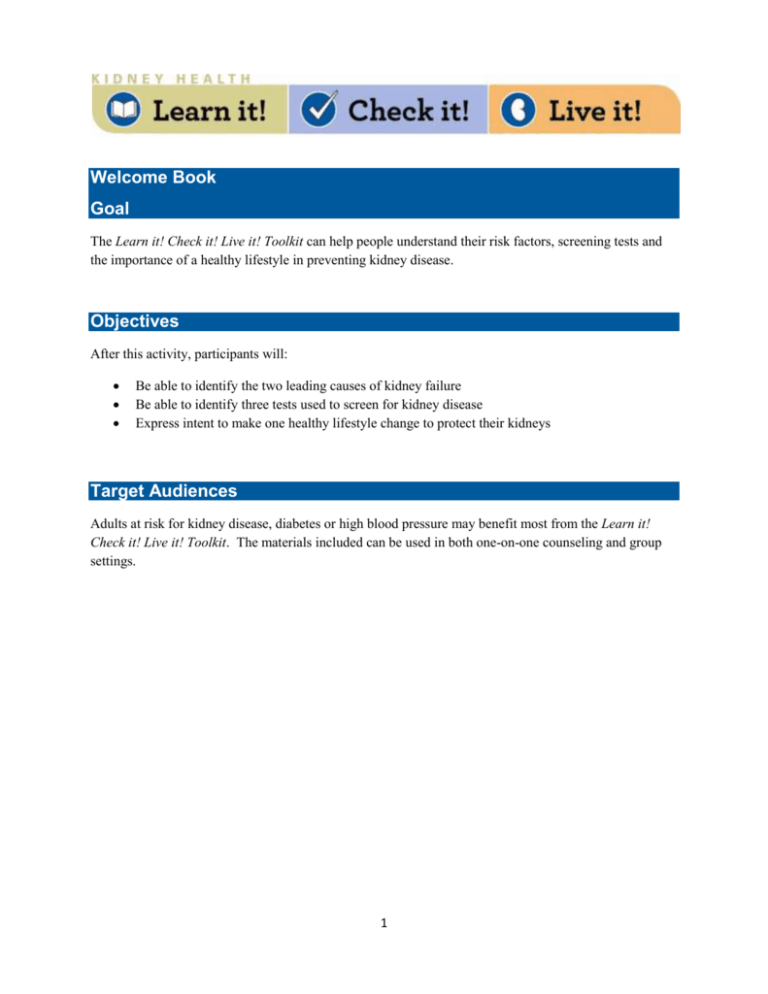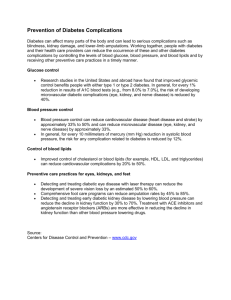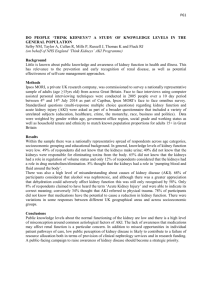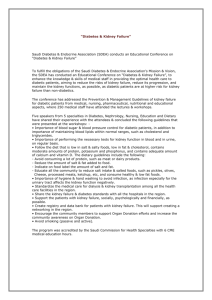Raise Funds to Fight Kidney Disease
advertisement

Welcome Book Goal The Learn it! Check it! Live it! Toolkit can help people understand their risk factors, screening tests and the importance of a healthy lifestyle in preventing kidney disease. Objectives After this activity, participants will: Be able to identify the two leading causes of kidney failure Be able to identify three tests used to screen for kidney disease Express intent to make one healthy lifestyle change to protect their kidneys Target Audiences Adults at risk for kidney disease, diabetes or high blood pressure may benefit most from the Learn it! Check it! Live it! Toolkit. The materials included can be used in both one-on-one counseling and group settings. 1 Contents Introduction……………………………………………………………………….. 3 Toolkit Components………………………………………………………………. 4 Flipchart…………………………………………………………………... 5 Materials Packet………………………………………………………….. 7 Additional Information……………………………………………………………. 8 Presenter’s FAQs…………………………………………………………. 8 Talking Points…………………………………………………………….. 9 How Raise Awareness in Different Settings……………………………... 10 Raise Funds to Fight Kidney Disease……………………………………. 11 Resource………….…………………………….. ………………………………… 11 2 Introduction Thank you for joining the American Kidney Fund in the fight against kidney disease! The American Kidney Fund developed the Learn it! Check it! Live it! Toolkit to: Raise awareness about kidney disease and its risk factors Encourage those at risk for kidney disease to be screened Promote a healthy lifestyle to prevent kidney disease This toolkit is for anyone at risk for kidney disease, diabetes or high blood pressure. Diabetes and high blood pressure are the two biggest risk factors for kidney failure. These conditions cause almost three out of every four cases. Preventing or controlling diabetes and high blood pressure can help prevent kidney disease. The basic toolkit components include: Welcome Book Flipchart Materials Packet The American Kidney Fund suggests that you begin with the Welcome Book, followed by the Flipchart, and then the Materials Packet. The Welcome Book describes all other parts of the toolkit and suggests ways to use them to help prevent kidney disease. The “Additional Information” section, beginning on page 8, suggests other ways to raise awareness about kidney disease and support the American Kidney Fund in its efforts to fight kidney disease. Decide which parts of this toolkit will work best for your community. Use the toolkit to connect with people and to support them as they make healthier choices. Be creative. You may have new ideas for activities as you look over the materials. If you have any questions or concerns about a topic related to kidney disease, diabetes, high blood pressure, screening tests or a healthy lifestyle, please visit the American Kidney Fund online at www.kidneyfund.org or contact our toll-free HelpLine at 1.866.300.2900 or helpline@kidneyfund.org. 3 Toolkit Components A brief description of the toolkit components is below, followed by a more detailed explanation of each piece. The Welcome Book explains the toolkit components and suggests ways to use them to increase kidney disease awareness and prevention. The Flipchart is the most important component of the toolkit. It discusses kidney disease, including its risk factors, important screening tests, and steps to a healthy lifestyle aimed at prevention. The Materials Packet offers a: o Flyer, bulletin insert and check stuffer template to advertise educational sessions o Series of supporting fact sheets that help reinforce the lessons learned from the Flipchart o Participant and presenter evaluation forms 4 Flipchart The Flipchart is the main teaching tool in this kit. The other tools were created to support your effective use of the Flipchart. The Flipchart features four main sections: An introduction to the kidneys A “Learn it!” section that explains the risk factors for kidney disease A “Check it!” section that outlines the screening tests related to kidney function A “Live it!” section that promotes a healthy lifestyle to help prevent kidney disease People tend to remember messages better when they are delivered through a variety of methods. The Flipchart allows you to present the material in a “lecture” format, with visuals to help reiterate the main points. Suggested discussion questions are incorporated throughout the Flipchart to help engage participants and introduce examples of how the Flipchart messages can be applied to everyday life. How to Use the Flipchart This Flipchart may be different from others you have used. Rather than simply providing information, it encourages participants to take three action steps to help prevent kidney disease: Learn what may be putting you at risk for kidney disease. Check your kidneys, blood sugar and blood pressure. Live a healthy lifestyle. These three action steps are critical for preventing kidney disease, so it is important that you cover all three in your presentation. The American Kidney Fund recommends covering all of these sections in one educational session to help ensure that participants walk away with a complete understanding of what they can do to help prevent kidney disease. This should take approximately 60 minutes; though, the actual time may vary depending on group interaction. If time does not permit all three sections to be covered in the same educational session, the material may be broken into smaller sessions. In this case, a brief review at the beginning of each subsequent session can help ensure continuity of the messages. The Flipchart consists of two sets of slides. The slides with the images are the participant slides and should be shared with your audience. These slides can be projected as a PowerPoint presentation or printed and given to participants as a handout. The slides with the text are the presenter’s notes. These offer talking points, discussion questions and notes to help you cover the material in the Flipchart. 5 Flipchart Content Introduction o Welcome o The Kidneys o What is Kidney Disease? o How Can I Protect My Kidneys? Learn it! o Learn Your Risks o Diabetes o High Blood Pressure Check it! o Check Your Kidneys o eGFR o Urine Test o Blood Sugar o Blood Pressure Live it! o Live a Healthy Lifestyle o Be Physically Active o Eat a Healthy Diet o Be Mindful of Portions o Take Care of Yourself Conclusion Appendices o Appendix A: Check it! Kidneys o Appendix B: Check it! Diabetes o Appendix C: Check it! Heart Health o Appendix D: Check it! Other Tests References Tips for Presenting Read everything in the Flipchart ahead of time so that you will be familiar with the material and feel prepared for the presentation. Encourage participants to ask questions throughout the presentation. Tailor your presentation of the material, discussion questions and any activities to suit participants’ needs and knowledge levels. Engage participants throughout the presentation via the discussion questions. Praise any positive efforts and suggestions your participants make. Use the supporting materials included in the Materials Packet to reinforce the messages of the Flipchart. Have enough copies of handouts ready in advance. 6 Materials Packet The Materials Packet includes the following materials: Advertising templates o Flyer o Bulletin insert o Check stuffer Five supporting fact sheets o Kidney Health o Live it! Eat Healthy! o Live it! Move More! o You, Diabetes & Your Kidneys o You, Your Blood Pressure & Your Kidneys Two evaluation forms o Participant Evaluation Form o Presenter Evaluation Form How to Use These Materials The flyer, bulletin insert or check stuffer templates can be used to advertise an upcoming educational session. Print, make copies, and distribute these before the session to promote attendance. Use the supporting fact sheets to reinforce the information covered in the Flipchart. Print, copy and distribute the fact sheets so that participants can refer back to the information after the educational session. The evaluation forms are designed to gain feedback about the Learn it! Check it! Live it! Toolkit. o Print, copy and distribute the Participant Evaluation Form to gather information about the usefulness of the presentation. Collect and review the completed Participant Evaluation Forms. o Complete a copy of the Presenter Evaluation Form. o Mail all completed Evaluation Forms to the American Kidney Fund at: American Kidney Fund Public Education 6110 Executive Boulevard, Suite 1010 Rockville, MD 20852 7 Additional Information Presenter’s FAQs What should I do if people ask me questions about their personal health? Direct people to their health care providers. Don’t fall into the trap of giving medical advice. That is not your role or the purpose of this Toolkit. What should I do if a person is asking questions that I don’t know the answers to? If you don’t know, don’t guess. Don’t give medical information unless you are absolutely sure of the facts. Tell the person (or group) that you don’t know the answer but will try to find out and get back to them. Suggest that the person consult a health care provider for personal medical questions. You can also refer the person to the American Kidney Fund’s toll-free HelpLine at 1.866.300.2900 for more information. What should I do if I don’t think I can cover the entire Flipchart? Every section in the Flipchart is important. If time does not permit you to cover the Flipchart in one session, consider having multiple sessions, with a quick review at the beginning of each. What should I do if one participant in the group is doing all of the talking? You can deal with this situation in a couple of ways. Sometimes the person who is talking has a lot of good points. You may not want to stop him or her from talking, but you do want to make sure that everyone has a chance to speak. In that case, every once in a while, explain that you would like to go around the room and ask each person to respond to the topic or question being discussed. You might also tell participants that you would like them to adopt some “ground rules” for the discussion (for example, that only one person speaks at a time, that there is no interrupting, and that all opinions are welcome). 8 Talking Points When time or space does not permit you to hold an educational session, you can still raise awareness with shorter talking points. A list of suggestions is below. Choose the talking points that are most helpful for your audience. These statements can also be included in brief newsletter articles or emails to help raise awareness or promote an upcoming educational session. Control diabetes and high blood pressure! Diabetes and high blood pressure are the leading causes of kidney disease. If you have them, work with your doctor to control them. Get tested! The only way to know if you have diabetes, high blood pressure or kidney disease is to be tested. Talk to your doctor about being tested, or contact the American Kidney Fund’s HelpLine at 1.866.300.2900 to find a health clinic near you. Kidney disease often has no signs or symptoms. The only way to know how well your kidneys are working is to be tested. Ask your doctor for simple tests to check your kidneys. Millions of Americans have kidney disease. Millions more are at risk. Many have no idea. Ask your doctor what might be putting you at risk and what you can do to protect your kidneys. Live a healthy lifestyle to prevent or control diabetes, high blood pressure and kidney disease! Exercise often, and eat a diet low in salt and fat. Limit alcohol, avoid tobacco, and take medicines as your doctor prescribes them. 9 How to Raise Awareness in Different Settings How you raise awareness about kidney disease may vary depending on your setting. Think about your audience and what will best suit them. The American Kidney Fund suggests: Raise Awareness at Work Hold a “Lunch and Learn” educational session to present the Flipchart. o Advertise the session a couple weeks in advance via email, check stuffers, flyers or a company newsletter. o Use email, check stuffers, flyers or a company newsletter to remind participants of key messages after the session. Hold a kidney screening for employees. Contact the American Kidney Fund’s Director of Health Outreach at 1.800.638.8299 to get a free screening guide. Raise Awareness at Your Place of Worship Hold an educational session in a classroom or meeting space at your place of worship. o Advertise the session a couple weeks in advance via announcements, website posts, flyers or newsletter inserts. Hold a kidney screening for the congregation. Contact the American Kidney Fund’s Director of Health Outreach at 1.800.638.8299 to get a free screening guide. Raise Awareness at Your Next Family Gathering Hold an educational session at your next family reunion or holiday gathering. o If an educational session is not practical, see the “Talking Points” section on page 9 for tips to raise awareness with shorter statements. If your family gathering is large, consider holding a kidney screening. Contact the American Kidney Fund’s Director of Health Outreach at 1.800.638.8299 to get a free screening guide. Raise Awareness in Your Community Hold an educational session at your local library or community center. o Advertise the session a couple weeks in advance via email, flyers or local newspapers. Hold a kidney screening. Contact the American Kidney Fund’s Director of Health Outreach at 1.800.638.8299 to get a free screening guide. Raise Awareness at Your Barbershop or Salon Use the “Talking Points” section on page 9 to raise awareness about kidney disease among clients during their visits. 10 Raise Funds to Fight Kidney Disease Congratulations! You’ve reached the last page of the Welcome Book for the Learn it! Check it! Live it! Toolkit and are well on your way to raising awareness about kidney disease in your community. Thank you for helping us spread this important message! There are some simple ways that you can do even more to help the American Kidney Fund in the fight against kidney disease. You can support activities in your area and across the nation that will save lives by raising awareness and funds. Other ways to help include: Making a contribution through workplace giving campaigns like the Combined Federal Campaign or United Way. Simply select CFC#11404 or write in “American Kidney Fund.” Asking your employer about a matching gift program so that your contributions to the American Kidney Fund might be doubled or even tripled. Making memorial or honor contributions through our website www.kidneyfund.org. Considering the American Kidney Fund in your estate planning decisions. Your efforts will go a long way in helping to prevent kidney disease and assisting patients who already have it. You can rest assured that the money you help us raise will be used responsibly. The American Kidney Fund uses 97 cents out of every dollar raised for programs and services, helping one out of every five dialysis patients nationwide. To learn more about ways that you can help, please visit www.kidneyfund.org or contact the American Kidney Fund’s Director of Community Engagement at 1.800.683.8299 to get a free community fundraising guide. Resource Centers for Disease Control and Prevention. Road to Health User’s Guide. Atlanta GA: U.S. Department of Health and Human Services, Centers for Disease Control and Prevention; 2008. 11









